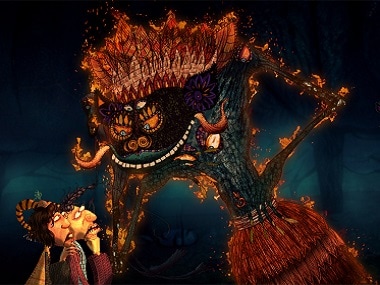Main hoon naada, tu pyjama Tu hai lota, main hoon paani Main aam, tu gutli Tu patakha, main sutli (I’m the drawstring, you’re the pyjamas You’re the pot, I’m the water I’m the mango, you’re the seed You’re the cracker, I’m the wick) [caption id=“attachment_6106301” align=“alignleft” width=“380”]  Goopy Gyne Bagha Byne receives the animation treatment[/caption] The quirky lyrics describe the bond between Goopi Gawaiiya and Bagha Bajaiiya, protagonists of GGBB, a new animation film that reimagines Satyajit Ray’s Goopy Gyne Bagha Byne. It is about Goopy the singer and Bagha the dhaak player, earnest underdogs who share an ineptness in and a passion for music. Boons of ghostly benevolence later, the duo sets off to distant lands on a magical adventure. Ray’s film was based on a story by his grandfather, Bengali novelist Upendrakishore Raychowdhry, which was published in the children’s magazine Sandhesh in 1915. GGBB — or Goopi Gawaiiya Bagha Bajaiiya — is filmmaker Shilpa Ranade’s effort to update the story for today’s children and adults alike. The film took a while to complete, and releases on March 1. Ranade, 52, is a designer, animator, illustrator and filmmaker, and a teacher at IIT Bombay’s Industrial Design Centre. She worked for over five years on GGBB, a film that won awards at various festivals, including the AASIFA Award for Best Animated Feature Film and Jury Award for Best Art Work at ICFF, Hyderabad. In a world where imagination is ruled by Disney and Pixar visions, Ranade’s effort is praiseworthy. Goopy Gyne Bagha Byne was pathbreaking fare. It marked Ray’s departure from his usual serious idiom. Despite low budget, Ray achieved technical feats considered impossible back then — the mesmerising_bhoot-er naach_ (dance of ghosts) sequence, for example. The film was about Ray taking a good story and turning it into great children’s cinema. Much has been written about the film’s underlying socio-political messages, but it is celebrated primarily for the joy it brings. The Ray family has played a significant role in upholding children’s fiction in Bengal. Says well-known Bangla translator Arunava Sinha: “There was a tradition of children’s fiction in Bangla before the film, though Upendrakishore was among early writers. Not only did his son and grandson (Sukumar and Satyajit Ray) follow in his footsteps, so did others in the family like Lila Majumdar and Sukhalata Rao.” Bengalis are understandably possessive about Goopy Gayen Bagha Bayen, and its sequels Hirak Rajar Deshe and Goopy Bagha Phire Elo. The trilogy gave Bengali culture memorable characters, legendary actors, and brilliant music. Is Ranade apprehensive? “Going by the reactions of Bengalis at festivals, I’m sure it will find a place in Bengali hearts. My version doesn’t challenge the story’s amazing lineage but pays homage to it,” she says. Like the original, GGBB is a musical, with eight songs composed by 3 Brothers & A Violin. Ranade’s painstaking handmade puppets match the homegrown sounds. The film’s release coincides with the 50th anniversary of Ray’s classic. Over three generations, Ray’s original has become a landmark for Bengali childhood, and is counted among the most inventive films in India. Ranade now takes the legacy forward in Hindi, for a generation more used to animation.
A new animation film that re-imagines Satyajit Ray’s evergreen Goopy-Bagha adventure might just be the affirmation that children’s cinema in India needs
Advertisement
End of Article


)
)
)
)
)
)
)
)
)



